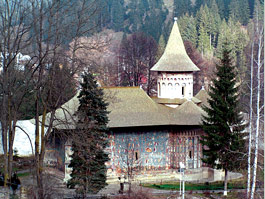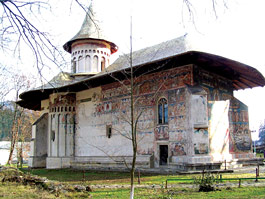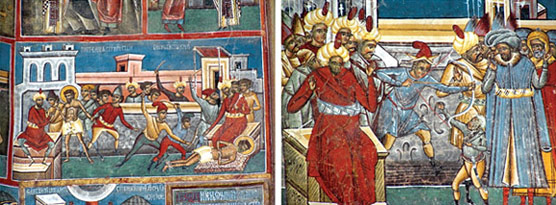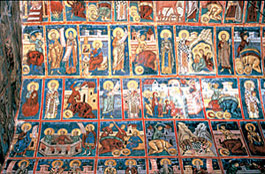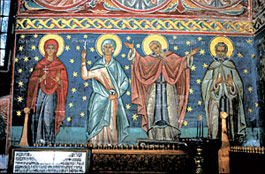Voronet Monastery
The Church of St. George  of the Voroneţ Monastery is possibly the most famous church of Romania.
of the Voroneţ Monastery is possibly the most famous church of Romania.
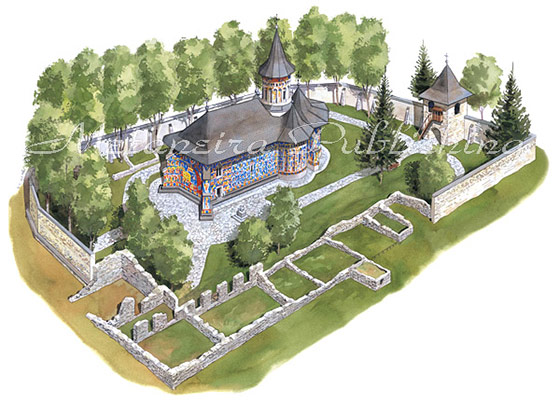
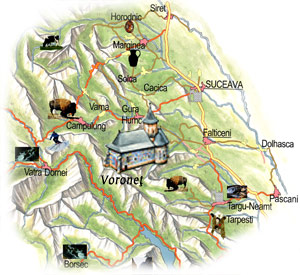
Year Built: 1488
Built by: Stephen the Great
Location: Voroneţ, Suceava County
Summary: It is known throughout the world for its exterior frescoes of bright and intense colours, and for the hundreds of well-preserved figures placed against the renowned azurite background. The church of Voroneţ that Stephen the Great built included the chancel, the naos with its tower, and the pronaos.
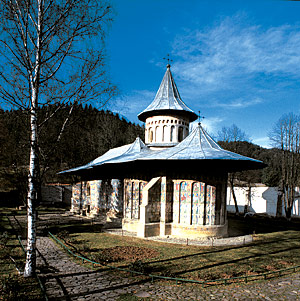
The monastery is located on a riverbank, at the end of the long and narrow village of the same name, near the town of Gura Humorului. The age of the monastic site is not known. A legend tells us that Stephen the Great, in a moment of crisis during a war against the Turks, came to Daniel the Hermit at his skete in Voroneţ and asked for advice. After he won the battle against the Turks, keeping his promise to the monk, the prince built a new church, dedicated to St. George, the bringer of victory in battle. This is the present church that was built on the site of an older wooden church, the scanty remains of which have not been dated. The renowned researcher George Balş wrote in the 1920’s that the churches of this period, and in part also those built in the following century, were “Byzantine churches built with Gothic hands”.The structure and the interior spatial solutions were linked to the Byzantine and south Slavic tradition.
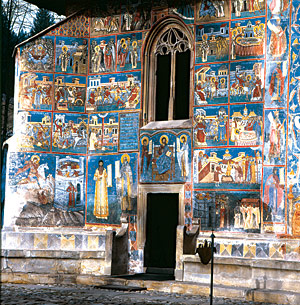
The exterior, with its buttresses and door and window frames were related to Western European High Gothic. The influences spread from Transylvania and Poland with craftsmen who were invited especially to build churches.
The Church of St. George is dated with the commemorative inscription placed above the original entrance, now in the exonarthex: “I, Prince Stephen, by God’s mercy leading the Country of Moldavia, son of Prince Bogdan, started to build this foundation at the Monastery of Voroneţ, dedicated to the Saint and Worshipped and Great Martyr and Victorious George, in the year 6996 (1488) the month of May, 26, the Monday after the Descent of the Holy Spirit, and completed it in the same year, in the month of September, 14”. The text shows that the church was built in less than four months. This tells us something about the high professional level of construction at the time, especially taking into account that the Church of St. Elijah in Suceava was built exactly at the same time.
{tours-banner-scroll}
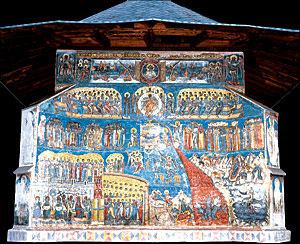
The church of Voroneţ that Stephen the Great built included the chancel, the naos with its tower, and the pronaos, which means that its plan was identical to the churches of Patrauti, St. Elijah and Milişăuţi. In 1547, the Metropolitan Bishop of Moldavia Grigore Roşca added the exonarthex to the west end of the church. The small windows, their rectangular frames of crossed rods and the receding pointed or shouldered arches of the interior doorframes are Gothic. The south and north doors of the exonarthex of 1547 have rectangular frames, which indicate a transition period from Gothic to Renaissance. But, above them, on each wall is a tall window with a flamboyant Gothic arch. The whole west façade is without any openings, which indicates that the intention of Metropolitan Roşca was since the beginning to reserve it for frescoes.
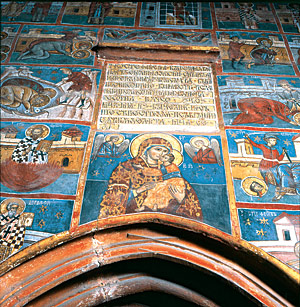
The exonarthex, as recounted above, was added by the Metropolitan Grigore Roşca in 1547. This addition changed the look of the small church, which up to now had been nearly identical with the still existing churches of Pătrăuţi and St. Elijah of Suceava. The exonarthex is a rectangular space with a transversal barrel vault. The west wall is without an opening, but on both lateral walls there is an entrance and a tall Gothic window.
During the half century that separates the paintings of the exonarthex from those of the naos, Moldavian art had evolved from sober and rigorous to more complex, decorative and lively. Floral decorations fill all available empty space, divide scenes and registers, and accentuate architectural elements such as niches and arches. The clothes of the figures turn from simple into sumptuous, and the bleak landscapes are now filled with vegetation. Details win ground where earlier spiritual intensity was most important.
Voronet is 4 km south of Gura Humorului where you can find accommodations and travel information. The town can be reached by railway after a 47 km ride from Suceava and 32 km from Campulung Moldovenesc, while by road the distance on E 58 is 36 km to both Suceava and Campulung Moldovenesc.
Contact:
Address: Voronet commune, Gura Humorului, 725300, Suceava County
Phone: + 40 (230) 235323
Mobil: + 40 (744) 560001
